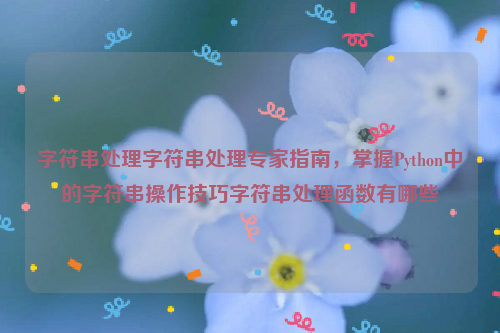Python中的字符串操作技巧有很多,空格剥离、字符串拆分、将列表元素合成字符串、字符串反转大小写、转换检查是否有字符串成员、子字符串替换、组合多个列表的输出、检查字谜和检查回文等。这些技巧可以帮助您更好地处理字符串。
在编程中,字符串处理是一个非常重要的技能,无论是在日常开发中还是在处理大量数据时,我们都需要对字符串进行操作,本文将为你提供一个全面的指南,帮助你掌握Python中的字符串处理技巧。
我们需要了解字符串是什么,在Python中,字符串是由字符组成的有序集合,可以用单引号、双引号或三引号表示。'hello'、"world" 和 '''hello world''' 都是字符串。

我们将介绍一些常用的字符串操作方法。
1、字符串拼接
在Python中,我们可以使用加号(+)将两个字符串连接在一起。
str1 = 'hello' str2 = 'world' result = str1 + str2 print(result) # 输出:helloworld
2、字符串分割
有时,我们需要将一个长字符串按照某个分隔符分割成多个子字符串,在Python中,我们可以使用split()方法来实现这个功能。
text = 'hello,world'
result = text.split(',')
print(result) # 输出:['hello', 'world']3、字符串替换
我们需要将字符串中的某个子串替换为另一个子串,在Python中,我们可以使用replace()方法来实现这个功能。
text = 'hello world'
result = text.replace('world', 'Python')
print(result) # 输出:hello Python4、字符串大小写转换
在Python中,我们可以使用upper()方法将字符串转换为大写,使用lower()方法将字符串转换为小写。
text = 'Hello World' upper_text = text.upper() lower_text = text.lower() print(upper_text) # 输出:HELLO WORLD print(lower_text) # 输出:hello world
5、字符串去除空格
有时,我们需要去除字符串中的空格,在Python中,我们可以使用strip()方法来实现这个功能。
text = ' hello world ' result = text.strip() print(result) # 输出:hello world
6、字符串查找与替换
我们需要在一个字符串中查找特定的子串,并将其替换为另一个子串,在Python中,我们可以使用find()方法查找子串的位置,然后使用replace()方法进行替换。
text = 'hello world'
index = text.find('world')
if index != -1:
result = text[:index] + 'Python' + text[index + len('world'):]
else:
result = text
print(result) # 输出:hello Python or hello world if 'world' not found in the string7、格式化字符串
在Python中,我们可以使用f-string或者format()方法来格式化字符串。
name = 'Tom'
age = 18
result = f'My name is {name} and I am {age} years old.' # 或者使用 format() 方法:result = 'My name is {} and I am {} years old.'.format(name, age)
print(result) # 输出:My name is Tom and I am 18 years old. or My name is Tom and I am 18 years old. depending on the version of Python being used (f-strings were introduced in Python 3.6)
